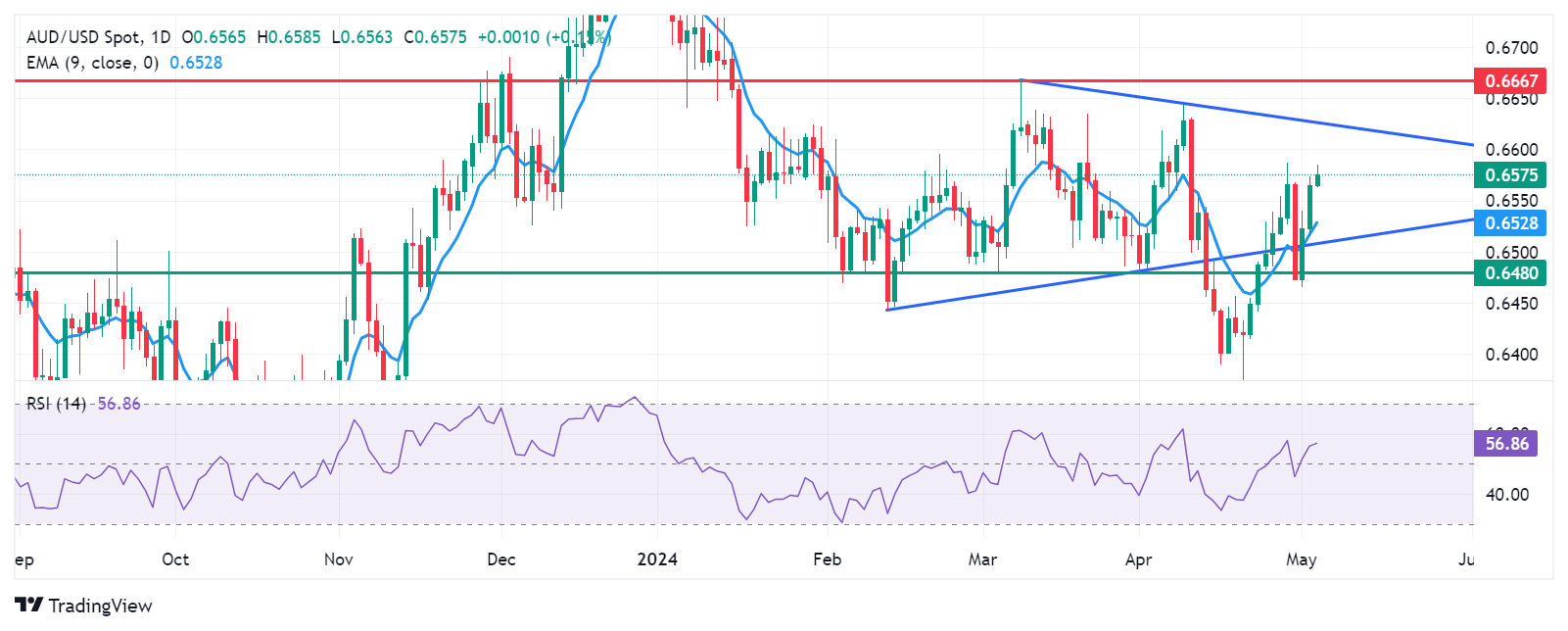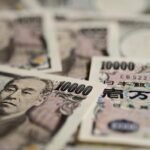- The Australian Dollar rises on hawkish sentiment surrounding the RBA prolonging higher interest rates.
- Australia’s central bank is expected to maintain its current rate at 4.35% until the end of September.
- US Nonfarm Payrolls is expected to print a reading of 243K for April, compared to 303K prior.
The Australian Dollar (AUD) continues its winning streak for the third successive session on Friday. The hawkish sentiment surrounding the Reserve Bank of Australia (RBA) bolsters the strength of the Aussie Dollar, consequently, underpinning the AUD/USD pair.
Australia’s central bank is expected to maintain its key policy rate at 4.35% for a fourth consecutive meeting on Tuesday, and likely until the end of September, as per a Reuters poll of economists. These economists predict only one interest rate cut this year. The higher-than-expected domestic inflation data released last week has raised expectations that the RBA may delay interest rate cuts.
The US Dollar Index (DXY), which gauges the performance of the US Dollar (USD) against six major currencies, remains under pressure following the dovish comments from US Federal Reserve (Fed) Chairman Jerome Powell after Wednesday’s decision to maintain interest rate range of 5.25%-5.50%. Powell’s dismissal of the possibility of another rate hike has contributed to the USD’s weakening.
Market attention has now turned to the US employment data for April, scheduled for later on Friday, which includes Average Hourly Earnings, Nonfarm Payrolls, and ISM Services PMI. These releases are expected to offer additional insights into the condition of the United States (US) economy.
Daily Digest Market Movers: Australian Dollar appreciates due to positive market sentiment
- The Judo Bank Australia Composite Purchasing Managers Index (PMI) declined to 53.0 in April from the previous reading of 53.3. This indicates a slightly slower growth in Australian private sector output. The growth in business activity was mainly confined to the service sector while manufacturing output continued to decrease. Specifically, the Services PMI fell to 53.6 from 54.4 in the previous month.
- The ASX 200 Index saw gains for the second consecutive session on Friday, propelled by positive movements on Wall Street overnight. These gains were driven by reassurances from the US Federal Reserve, which dismissed concerns about another interest rate hike.
- US Initial Jobless Claims data reported that the number of individuals claiming unemployment benefits remained unchanged from the previous week at 208K for the week ending April 26. This figure stays at the lowest level in two months and is notably below market expectations of 212K, potentially providing the Federal Reserve with the flexibility to postpone interest rate cuts.
- US Nonfarm Productivity rose by 0.3% in the first quarter, following an upwardly revised 3.5% increase in the previous quarter and falling short of the expected increase of 0.8%. It was the weakest pace of productivity increase since the January-March quarter in 2023.
- On Thursday, Australia’s Trade Balance (MoM) data posted a surplus, however, it was lower than market expectations for April. Additionally, Building Permits data showed an increase in the number of permits for new construction projects in March, albeit falling short of expectations.
- Federal Reserve Chairman Jerome Powell highlighted that progress on inflation has recently stalled, suggesting that it would take more time than previously anticipated before the Fed could confidently expect inflation to approach its 2% target. Powell mentioned that if robust hiring persisted and inflation remained stagnant, it would justify delaying rate cuts.
- According to the CME FedWatch Tool, the probability of the Federal Reserve keeping interest rates within their current range of 5.25%-5.50% during the June meeting has decreased to 85.8%, down from 90.0% a week ago. Conversely, the likelihood of a 25-basis point rate cut has increased to 14.2% from 9.7% compared to a week ago.
Technical Analysis: Australian Dollar could test the psychological level of 0.6600
The Australian Dollar trades around 0.6570 on Friday. The pair is positioned in a symmetrical triangle pattern, with the 14-day Relative Strength Index (RSI) above the 50-level, indicating a bullish bias.
The AUD/USD pair might test the psychological level of 0.6600, followed by the upper boundary around the level of 0.6630. A breakthrough above this level could lead the pair to explore the region around March’s high of 0.6667.
On the downside, the AUD/USD pair could move toward the nine-day Exponential Moving Average (EMA) at 0.6528, followed by the lower boundary of the symmetrical triangle around the psychological level of 0.6500. A break below the latter could exert pressure on the pair to test the throwback support at the 0.6480 level.
AUD/USD: Daily Chart

Australian Dollar price today
The table below shows the percentage change of Australian Dollar (AUD) against listed major currencies today. Australian Dollar was the strongest against the US Dollar.
| USD | EUR | GBP | CAD | AUD | JPY | NZD | CHF | |
| USD | -0.03% | -0.09% | -0.02% | -0.06% | -0.06% | -0.09% | -0.04% | |
| EUR | 0.04% | -0.04% | 0.02% | -0.01% | 0.02% | -0.02% | -0.01% | |
| GBP | 0.08% | 0.05% | 0.07% | 0.03% | 0.04% | 0.01% | 0.05% | |
| CAD | 0.02% | -0.02% | -0.07% | -0.03% | -0.02% | -0.05% | -0.02% | |
| AUD | 0.06% | 0.01% | -0.04% | 0.03% | 0.02% | -0.03% | 0.02% | |
| JPY | 0.06% | 0.00% | -0.06% | 0.00% | 0.00% | 0.00% | -0.02% | |
| NZD | 0.07% | 0.02% | -0.01% | 0.07% | 0.03% | 0.04% | 0.05% | |
| CHF | 0.04% | 0.01% | -0.05% | 0.01% | -0.01% | 0.01% | -0.05% |
The heat map shows percentage changes of major currencies against each other. The base currency is picked from the left column, while the quote currency is picked from the top row. For example, if you pick the Euro from the left column and move along the horizontal line to the Japanese Yen, the percentage change displayed in the box will represent EUR (base)/JPY (quote).
RBA FAQs
The Reserve Bank of Australia (RBA) sets interest rates and manages monetary policy for Australia. Decisions are made by a board of governors at 11 meetings a year and ad hoc emergency meetings as required. The RBA’s primary mandate is to maintain price stability, which means an inflation rate of 2-3%, but also “..to contribute to the stability of the currency, full employment, and the economic prosperity and welfare of the Australian people.” Its main tool for achieving this is by raising or lowering interest rates. Relatively high interest rates will strengthen the Australian Dollar (AUD) and vice versa. Other RBA tools include quantitative easing and tightening.
While inflation had always traditionally been thought of as a negative factor for currencies since it lowers the value of money in general, the opposite has actually been the case in modern times with the relaxation of cross-border capital controls. Moderately higher inflation now tends to lead central banks to put up their interest rates, which in turn has the effect of attracting more capital inflows from global investors seeking a lucrative place to keep their money. This increases demand for the local currency, which in the case of Australia is the Aussie Dollar.
Macroeconomic data gauges the health of an economy and can have an impact on the value of its currency. Investors prefer to invest their capital in economies that are safe and growing rather than precarious and shrinking. Greater capital inflows increase the aggregate demand and value of the domestic currency. Classic indicators, such as GDP, Manufacturing and Services PMIs, employment, and consumer sentiment surveys can influence AUD. A strong economy may encourage the Reserve Bank of Australia to put up interest rates, also supporting AUD.
Quantitative Easing (QE) is a tool used in extreme situations when lowering interest rates is not enough to restore the flow of credit in the economy. QE is the process by which the Reserve Bank of Australia (RBA) prints Australian Dollars (AUD) for the purpose of buying assets – usually government or corporate bonds – from financial institutions, thereby providing them with much-needed liquidity. QE usually results in a weaker AUD.
Quantitative tightening (QT) is the reverse of QE. It is undertaken after QE when an economic recovery is underway and inflation starts rising. Whilst in QE the Reserve Bank of Australia (RBA) purchases government and corporate bonds from financial institutions to provide them with liquidity, in QT the RBA stops buying more assets, and stops reinvesting the principal maturing on the bonds it already holds. It would be positive (or bullish) for the Australian Dollar.

























